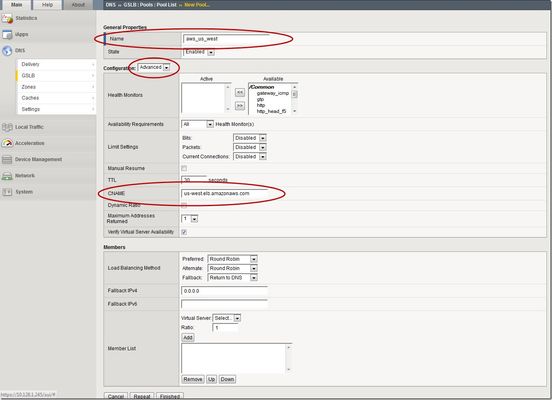Using BIG-IP GTM to Integrate with Amazon Web Services

 Cirrus
Cirrus
IMHO, the original article definitely contains a wealth of information on how to utilize F5 BIG-IP GTM (and BIG-IP LTM also) to coordinate Global Server Load Balancing (GSLB) with a cloud service or content distribution network (CDN) provider that has requirements that are not compatible with classic DNS (i.e., BIND). Thus, the initial steps of the article that use:
o an HTTP re-direct for FQDN example.com (via an LTM virtual server)
o a CNAME record for FQDN www.example.com so that it resolves to canonical name FQDN example.lb.example.com
o the DNS delegation of the subdomain FQDN lb.example.com to the GTM
all act to nicely setup the remaining steps that use the wide-IP, GTM pool, and Topology features of BIG-IP DNS.
However, as noted by a couple of previous commenters, since the article was written prior to TMOS v12 the rest of the article where these GTM features are now used suffers from incompatibity with the BIG-IP DNS versions of today. Specifically:
o The wide-IP and GTM pools at v12 and later releases need to have DNS record type declarations.
o Furthermore, the DNS record type declarations between wide-IPs and their pools and pool members must adhere to certain rules.
[NOTE: For an excellent treatment of how these v12+ features are utilized, see Lee Orrick's BIG-IP DNS v12 series of articles and videos at
https://community.f5.com/t5/technical-articles/big-ip-dns-resource-record-types-architecture-design-and/ta-p/288804.]
Hopefully, the following revised steps based on the original article will demonstrate how the remaining steps work with BIG-IP DNS today. I used tmsh commands because, given that the pre-v12 and v12+ version wide-IP and GTM pool GUI screens are quite similar looking, it seemed more meaningful to use the tmsh commands as they explicitly document at the "detail level" the specifics of what objects with what record types go where.
[NOTE: Although the example scenario of the original article was based on one cloud service provider in particular, I thought I would make what follows a little more generic. So in the following scenario, it is the fictional cloud service provider "glowebsvc.com" that is used. And when it comes to "west" and "east" in a topological sense, I am simply going to consider the former to mean the Western Hemisphere and the latter to be the Eastern Hemisphere, just to make things simple.]
So, using the original article as our guide ...
o The first step will be to create a GSLB pool named "glo_east" of type CNAME that contains the static-target canonical name east.elb.glowebsvc.com:
# tmsh create /gtm pool cname glo_east members add { east.elb.glowebsvc.com { static-target yes } }
# tmsh list /gtm pool cname glo_east
gtm pool cname glo_east {
members {
east.elb.glowebsvc.com {
member-order 0
static-target yes
}
}
}
o Then, we create another GSLB pool named "glo_west" of type CNAME that contains the static-target canonical name west.elb.glowebsvc.com:
# tmsh create /gtm pool cname glo_west members add { west.elb.glowebsvc.com { static-target yes } }
# tmsh list /gtm pool cname glo_west
gtm pool cname glo_west {
members {
west.elb.glowebsvc.com {
member-order 0
static-target yes
}
}
}
o Next, we create a wide-IP of type A for the FQDN example.lb.example.com that contains the two GSLB pools of type CNAME that we just created above:
# tmsh create /gtm wideip a example.lb.example.com pools-cname add { glo_west glo_east }
# tmsh list /gtm wideip a example.lb.example.com
gtm wideip a example.lb.example.com {
pools-cname {
glo_east {
order 1
}
glo_west {
order 0
}
}
}
o Next, we create the topological region named "western_hemisphere", defining it to be North America ("NA") and South America ("SA"):
# tmsh create /gtm region western_hemisphere region-members add { continent NA continent SA }
# tmsh list /gtm region western_hemisphere
gtm region western_hemisphere {
region-members {
continent NA { }
continent SA { }
}
}
o Then, we create the topological region named "eastern_hemisphere", defining it to simply be anywhere not in the region "western_hemisphere":
# tmsh create /gtm region eastern_hemisphere region-members add { not region western_hemisphere }
# tmsh list /gtm region eastern_hemisphere
gtm region eastern_hemisphere {
region-members {
not region /Common/western_hemisphere { }
}
}
o Next we create the associated topology records so that the requests from the two defined regions will go to their applicable GTM pools:
# tmsh create /gtm topology ldns: region western_hemisphere server: pool glo_west score 100
# tmsh create /gtm topology ldns: region eastern_hemisphere server: pool glo_east score 100
# tmsh list /gtm topology
gtm topology ldns: region /Common/western_hemisphere server: pool /Common/glo_west {
order 1
score 100
}
gtm topology ldns: region /Common/eastern_hemisphere server: pool /Common/glo_east {
order 2
score 100
}
o Finally, we modify the pool settings under the wide-IP example.lb.example.com to use "Topology" as the load balancing method.
# modify /gtm wideip cname example.lb.example.com pool-lb-mode topology
# list /gtm wideip cname example.lb.example.com
gtm wideip cname example.lb.example.com {
pool-lb-mode topology
pools {
glo_east {
order 1
}
glo_west {
order 0
}
}
}
Help guide the future of your DevCentral Community!
What tools do you use to collaborate? (1min - anonymous)